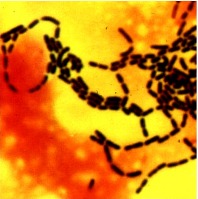Lactobacillus rhamnosus
| Lactobacillus rhamnosus GG | ||||||||||||||
|---|---|---|---|---|---|---|---|---|---|---|---|---|---|---|
| Scientific classification | ||||||||||||||
| ||||||||||||||
| Binomial name | ||||||||||||||
| Lactobacillus rhamnosus GG |
Description and significance
Lactobacillus rhamnosus GG (LGG) was isolated in 1983 from a healthy human and was indicated to be a strain of Lactobacillus rhamnosus by Sherwood Gorbach and Barry Goldin. L.rhamnosus GG is a probiotic bacteria known for its beneficial effects on the intestinal tract and can also boost a persons immune system. This helpful bacteria is said to balance the microfauna of the gastrointestinal tract. LGG can stimulate antibody production, enhances phagocytosis( a process in which an immunity cell engulfs foreign invaders), and modifies production of cytokines which are important proteins in the immune response. LGG is also known to decrease the proliferation of carcinogenic elements by other bacteria living in the intestine. In addition, in 2005 LGG was used to treat gastrointestinal carriage of vancomycin-resistant enterococci in patients with kidney problems. L. rhamnosus GG has shown to shorten the rotavirus diarrhoea (Guandalini et. al 2000), relief inflammatory bowel disease (Gupta et. al 2000), and treat and prevent allergies (Kalliomaki et al. 2001b)
Since it has so many positive effects on the human body, it is now available to buy in dairy products or in form of capsules to ingest orally.
Genome structure
The genomic sequence of Lactobacillus rhamnosus GG consists of over three million nucleotides which make up approximatly 3100 genes. Compared to other probiotic bacteria, this genome is quite large, allowing LGG to propogate a greater diversity of qualities which perhaps explains why it can benefit people in a number of different ways.
Cell structure and metabolism
Lactobacillus rhamnosus GG are a rod shaped, nonmotile aerobic bacteria thats ferments lactic acid from sugars.
Ecology
Commercial Importance
Current Research
Lactobacillus rhmnosus GG is the most studied probiotic bacteria today. A lot of research is being conducted on the effects it has on the gastrointestinal tract and the effects it has on cancer patients and people experiencing diarrhea.
Probiotics: an overview of beneficial effects
Is Lactobacillus GG Helpful in Children with Crohn's disease? Results of a Preliminary, Open-Label Study
Lactobacillus supplemaentation for diarrhoea related to study chemotherapy of colorectal cancer: a randomised study
